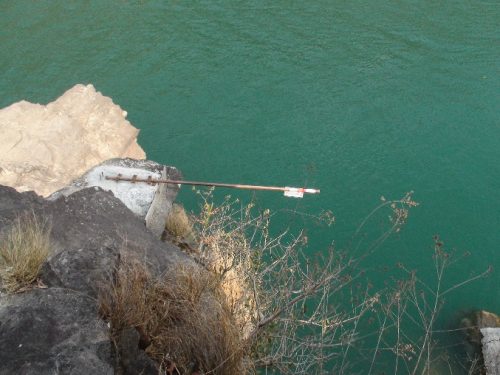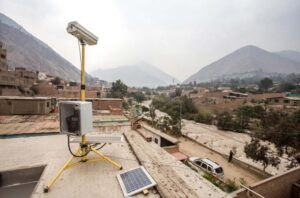
This is part of a series of blog posts written about our work, by the author Kevin Sene in his book – Hydrometeorology: Forecasting and Applications. Sene K. (2024)
Community based early warning systems are widely used to extend the coverage provided at a national level.
However, in low to middle income countries, budgets are often limited, which has led to the search for low-cost alternatives employing some of the latest technologies.
The international development group Practical Action has been at the forefront of commissioning research in this area. For example, in Nepal, low cost lidar-based techniques have been trialled for monitoring river levels, while in Peru 3D printers have been used to help produce meteorological stations. Both approaches use open source hardware and software allowing the latest ideas and science to be rapidly shared worldwide and replacement parts to be sourced or manufactured locally, rather than through an international supplier.
Mounted above the water surface, the lidar system uses a low-powered laser to transmit near-infrared light downwards while a sensor detects the intensity of reflected light (Paul et al. 2020). The signal is processed by an Arduino-based data logger. The general concept is similar to the rather better-known use of lidar in digital terrain mapping of floodplains.
During trials in Nepal, a portable device was tested at two sites in the Karnali river basin alongside radar level sensors within the national hydrometric network (Practical Action 2020a). The trials suggested that levels could be measured with an accuracy of about 2.5 cm over a range of about 30 metres, compared to a value of 5 metres with a low cost ultrasonic instrument. A large range is an important consideration in Nepal’s fast responding mountain-fed rivers.
The indicative cost of each instrument was a few hundred dollars and, importantly, consultations and demonstrations were performed at national, district and community level to see how these sensors might be integrated into both national and community-based flood warning systems (Pandeya et al. 2021). The likelihood of community buy-in and ownership were particular considerations for the long term sustainability of this Citizen Science approach.
These trials complemented other Practical Action monitoring initiatives in Nepal such as providing staff gauges for use by gauge readers and technical advice at a national level regarding priorities for extension of the hydrometric network.

Lidar sensor at Chisapani Station in Nepal (Uprety 2017)
In Peru, the focus was on rainfall monitoring, which is a particular priority due to frequent devastating flash floods and mudflows along the Andes and in coastal ravines. Known in the Quechuan language as huaycos, these often occur in areas not served by the national hydrometric network, which is a common problem worldwide with smaller scale, fast responding events.
The latest 3D printing techniques provide a possible low cost way of extending weather station coverage (Aréstegui 2018, Practical Action 2020b). The main unit costs are for a solar panel power supply, the thermoplastic filament for 3D printing of sensor housings, a support structure, and a Raspberry Pi microcomputer. Here, Raspberry Pi is another open source initiative that originally arose out of the wish to facilitate teaching computer science in schools but whose state-of-the-art processors are now widely used in meteorological and industrial applications. Again, the indicative cost was a few hundred dollars, while ongoing cellular data transmission costs were comparable to normal cell phone tariffs.
The resulting design is called Qawaq from the Quechuan word for ‘the one who looks’. Other innovations include a web-based platform for displaying observations and the use of instant messaging services to send notices, alarms and warnings to community brigade leaders. Additional sensors are easily added, such as commercially available rain gauges, cameras to automatically transmit images of river levels, and soil moisture sensors to help farmers with improving irrigation efficiency.
These trials all form part of wider support by Practical Action in Peru for developing and improving early warning systems. This include initiating a Citizen Science rainfall observation network using locally made rain gauges, and exploring ways of validating newer technologies such as Qawaq and integrating them into the national network. This book also illustrates innovations in flood warning dissemination that might be applied elsewhere.

Early version of a monitoring station installed in Chosica, Lima, Peru (Practical Action 2020b)